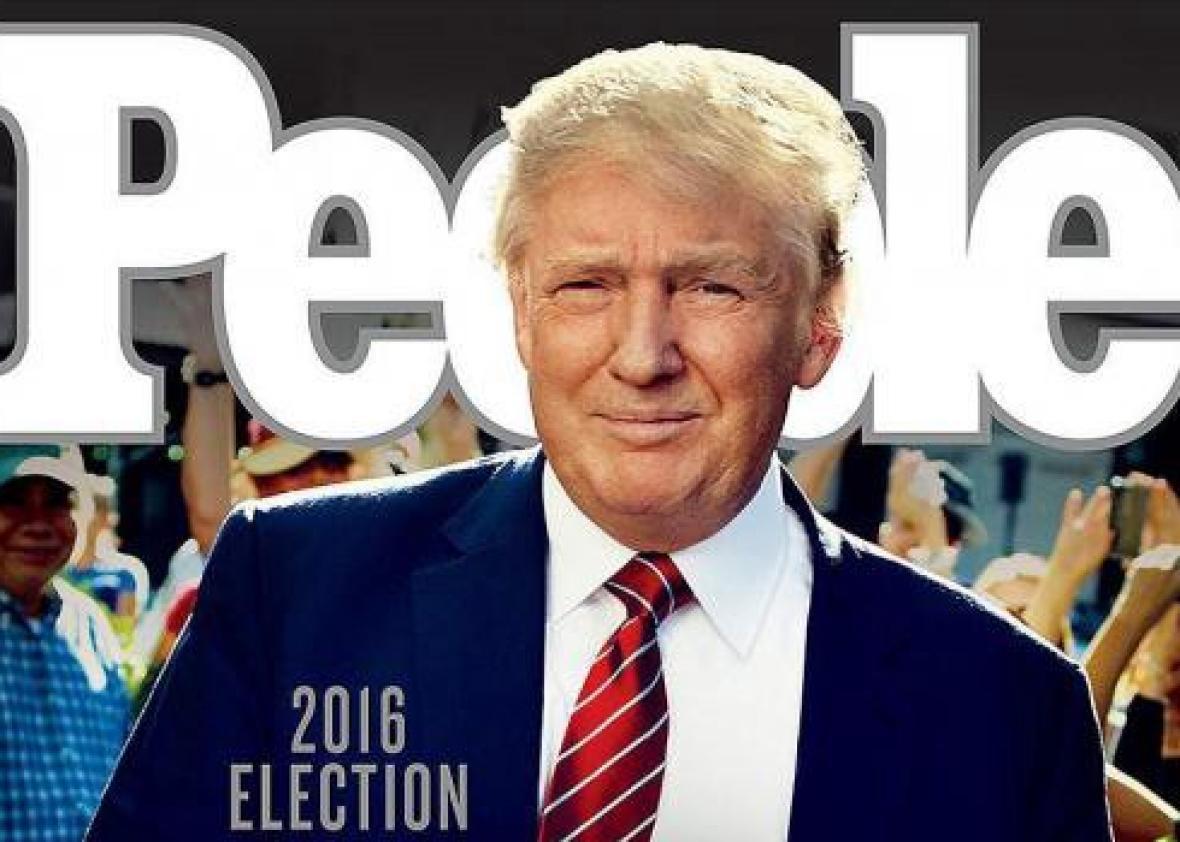Since more than 61 million Americans voted for a sexual predator who wants to monitor all Muslims via a national registry, People magazine has taken bold steps to give those voters what they want: a warm and fuzzy look at Donald Trump’s life and grandkids.
The magazine has taken a lot of flack over the last two days for a slideshow that celebrated the “way too cute” family of Ivanka Trump, who helped mitigate her father’s lifelong debasement of women, and a flattering cover of Donald Trump that might as well have been an installment of the “Sexiest Man Alive” series.
In a staff memo sent Thursday afternoon and obtained by Slate, People editor-in-chief Jess Cagle explained and defended the reasoning behind his decision:
Dear Colleagues,
This week the PEOPLE cover story is about president-elect Donald Trump, and as you may have seen, we are getting some heat for it. We’ve been called out for trying to pander or “normalize” Trump, just weeks after we published a story, by former PEOPLE writer Natasha Stoynoff, about being physically attacked by Trump in 2005.
I assure you that the cover on the president-elect is in no way a celebration or endorsement of this deeply polarizing figure. And we continue to stand steadfastly by Natasha. Her attack is of course recounted in the cover story. Last Friday, we posted a video in which she again discusses the attack and responds to the nasty things Trump has said about her recently. We will never forget what happened to Natasha, and frankly we don’t want our audience to forget, either.
Some readers are sickened to see Trump on the cover. Others are thrilled by it. In any case, it seemed wrong to put anyone other than the president-elect on the cover this week. He was elected president. We can’t pretend it didn’t happen. Some of you have been criticized on social media for my decision. This is unfortunate and unfair to you. Some of you may personally disagree with the decision. I’m here if anyone wants to talk.
Let me assure you that no matter who is in the White House, PEOPLE celebrates tolerance and inclusion. We strive to entertain, empower and inspire our audience. We will continue to do all the things that make us proud. Our campaign against gun violence, for example, will continue with renewed fervor.
Thanks for listening, and thanks for the great work you’re doing.
Jess
What Cagle doesn’t recognize is this: The problem is not that Trump is on the cover of a magazine. He’ll likely feature prominently on the next issue of every U.S. magazine, and many, many more covers in years to come. Trump has been Slate’s home page cover boy about two weeks out of every three for the last six months. But giving Trump the glamour-shot treatment with no recognition of the undisputed threat to American ideals he poses is an irresponsible abdication of journalistic ethics. This man has allegedly sexually assaulted a People reporter, advocated for war crimes, and promised to crack down on the free press, and he is about to become the most powerful person in the world. And all People can do is ponder “his life, his family, and his astonishing journey”?
It’s hard to know what it means to be a journalist in the Trump era, in which it’s become clear that facts matter less than fear-driven bigotry to a large proportion of the people who determine the direction of our representative democracy. Part of the problem, as a zillion essays have echoed, is that social media networks, fake news outlets, and geographic realities form insulated bubbles around our social circles, creating echo chambers that are increasingly difficult to escape. That’s one reason—in addition to misleading poll results and a general hope for the decency of humanity—why most journalists failed to consider the possibility of a Trump win until it had already happened.
People magazine, one of the most-read magazines in the U.S. with a circulation of more than 3.4 million, has the rare potential to break through those bubbles, to be a kind of first responder to the virus that’s incubating in isolated, majority-white communities and infecting marginalized people around the country. Members of a wide range of socioeconomic groups, political ideologies, and racial worldviews read People. No one can measure the incremental positive impact publishing an interview with Laverne Cox about the word transvestite has on perceptions of transgender identity in places that are hostile to queer and trans people. But the impact is undeniable. Islamophobic people in big cities and small towns alike read People. Imagine if the sunny, nonthreatening magazine in their nail salons or aunts’ living rooms refused to ignore the unprecedented danger he presents.
Trump is not just any winning Republican candidate. The problems with his character and proposed policies aren’t a matter of budget disputes or general hawkishness or taxes. They’re about the very building blocks of personal safety and the constitutional rights and freedoms of people in America. At Slate and other news outlets condemned by Trump as rigged homes for media elites, our explanations of Trump’s lies, hypocrisies, and threats often go discounted or unread by people most susceptible to those lies. People’s deep and broad popularity—especially among readers Cagle called out as “thrilled” by that cover—offers a way around that sociocultural barrier. It’s not just a responsibility on journalistic terms. It’s an enormous opportunity for our country.
